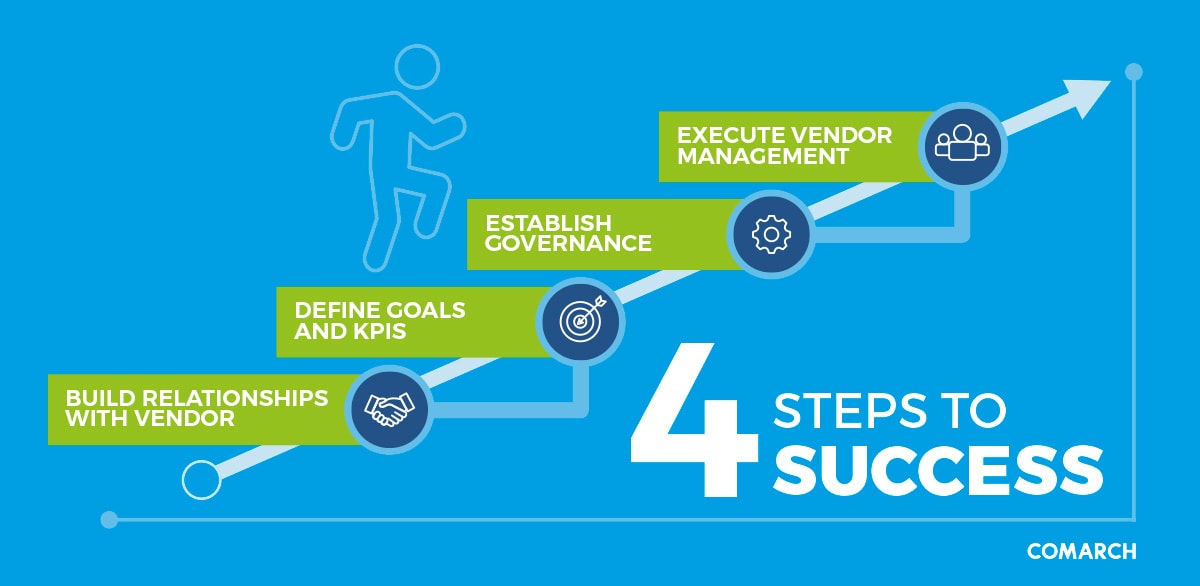Vendor Management in IT Outsourcing - Success factors
Vendor Management is a critical activity in IT Outsourcing and it’s getting more and more popular. As we can read in Deloitte Global CPO Survey 2016: “The drive for outsourcing continues, especially in larger organizations.” According to Gartner’s definition Vendor Management is “a discipline that enables organizations to control costs, drive service excellence and mitigate risks to gain increased value from their vendors throughout the deal life cycle.”[1] Thus, it comprises the following phases: relationship development, contract management, governance and finance and commercial management.

This article is intended to present observations on Vendor Management from the perspective of the service provider. For 23 years, Comarch ICT has helped companies to optimize business costs by using the latest technologies and ensuring the highest data security standards. What are the key success factors in this process?
The example of a financial institution
Recently, we have been servicing a large financial institution. Our client was looking for a provider to:
- transition IT services from the current offshore provider to a nearshore location in Europe
- deliver the managed platform as a service and technical application management.
Both business and IT stockholders were involved because main driver for this project was transition and transformation of one of the business lines. The selection process was supported by the external consulting company, which has ensured structure and governance for the process.
Business and technological challenges
There were many business obstacles (i.e. related to HR) and also we have faced some challenges specific to an IT project. The most severe one was the tight schedule due to business restrictions. The contracting phase was scheduled for 3 months. Service transition was planned for as little as 4-6 months. Moreover, the international team was spread around the world. They were working remotely from very distant locations, which might cause some problems. Additional challenges were related to incomplete and outdated documentation as well as outdated infrastructure (lack of lifecycle updates and upgrades). Furthermore, the client requested flexibility of volumes and prices.
Focusing on the vendor management perspective will allow us to see areas that need to be monitored and managed from a different angle.
Relationship development
As we have seen before, different stakeholders were involved in the cooperation. These include client representatives (CIO, project manager, vendor manager and procurement), the consulting company and the provider’s representatives (account manager, IT architect, project manager and delivery manager). It is widely known that relationship development determines success in IT outsourcing projects and is very important at each step of the process. During vendor selection it supports business expectations management and understanding of client’s needs. During the contracting phase a good relationship helps to speed up the negotiation process. It also facilitates the project and removes project obstacles. And finally, the relationship supports service improvement and alignment with the client’s needs and expectations.
Contract management
Contract management is not just a contracting phase. In fact, this should be instigated before contracting – this is a good time to prepare the contract’s structure, to identify potential obstacles and areas that need further negotiations. During this phase, it is also important to prepare an agreement that can easily be managed once the contract has been signed. I can certainly recommend putting some “regular contract review” clauses in the steering mechanisms.
Governance, Issue & Dispute Management
Governance helps understand specific processes, identify responsibilities and define communication flows. It is important to establish governance for each step of the process (selection, contracting, transition and/or transformation, delivery). It is a good practice to consider the following questions beforehand:
- Who is the single point of contact?
- How often should we make project meetings and who should participate in them?
- How can we escalate issues? Who should we contact with in case of disputes?
- What are the KPIs (i.e. meeting frequency, reaction time on escalations, etc.)?
Regardless of all specific circumstances, I strongly recommend making it simple, feasible and accurate.
Finance and Commercial Management
In our case, the main challenge was related to variable costs. The aim was to correlate changing demand with capacity and generated costs (“pay-as-you-go” model). Based on these criteria the flexible pricing model was developed. Later on, during the service delivery phase, additional governance mechanisms were added to control current capacity utilization to better predict future costs. It was especially important to create an adaptive approach that provides flexibility and supports future demand changes (business upscale or downscale).
How to do it smoothly?
Proper vendor management is a key success factor for IT outsourcing projects. In our case, a good relationship and an agile approach enabled the IT transition to be finished on time. The entire platform was upgraded, so the risk of unavailability was reduced. End users constantly report that service quality is very high. Demand and capacity management is executed seamlessly and it helps to align costs with the business needs.
'Vendor Management in IT Outsourcing" Author:
Adam Tymofiejewicz, ICT Consulting Director, Comarch Luxembourg
[1] Source: http://www.gartner.com/it-glossary/vendor-management/
Learn more about: Cloud Infraspace
See more: Data Center
Comprehensive Services: IT Infrastructure Services
Cyber security: IT Risk Security Management